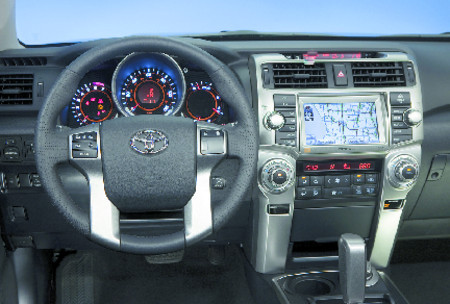4Runner proves versatile
If you're looking for a dilettante-pretty sport ute for night-life cruising or for tripping to the mall, the Toyota 4Runner will likely do the trick, but you would really be missing out on what this vehicle is all about.
The 4Runner has always been considered an honest off-roader that makes no apologies for its extra-firm ride and blue-collar body styling that is anything but downtown trendy. That image is reinforced to a greater extent with the 2010 edition, but fans of this go-anywhere rig will be pleased to discover that Toyota has tamed the 4Runner's appetite for fuel, while strengthening its ability to take on whatever moonscape-terrain its owners are brave enough to challenge.
The midsize 4Runner began back in 1984 as a fixed-roof version of Toyota's compact pickup and has retained its trucklike body-on-frame construction through the previous four generations and more than 1.5 million unit sales.
The all-new edition, while still maintaining its brutish good looks and relative size, actually appears a bit more civilized. Although the 4Runner is slightly taller than before, it borrows its platform from the retro-inspired FJ Cruiser, which means a lower floor height and a slightly less lofty perch.
But the biggest news is that the previously offered 260-horsepower 4.7-liter V-8 didn't make the cut for 2010, likely due to its abysmal 14/17 mpg city/highway fuel consumption that probably scared off many prospective 4Runner buyers during last year's off-the-scale gas prices.
Replacing it atop the power band is last year's base 4.0-liter V-6 that has been upgraded to 270-horsepower, a gain of 34 and 10 more horses than to outgoing V-8.
Additionally, the made-over V-6 earns a respectable city/highway mpg rating of 17/23. The new standard engine is now a 157-horsepower 2.7-liter four-cylinder that, while not significantly bettering V-6's consumption rating, should at least provide an attractive base price.
Four-cylinder models can only be had in rear-wheel-drive and are connected to four-speed automatic transmissions. The V-6 gets a five-speed automatic and is offered in rear drive or coupled to a part-time 4x4 system with a two-speed transfer case (low range for severe off-roading) that's available on SR5 and standard on Trail models. The luxury Limited's 4x4 option is a full-time unit with a locking center differential that's controlled by a console switch.
Base SR5 models come with climate control, multiadjustable power driver's seat, eight airbags (including two front-knee inflatables) and chrome roof rails. The 4x4 models are equipped with Hill Start Assist that keeps the vehicle from rolling backward when stopped on an incline. There's also Hill Descent Control to prevent unintended acceleration on a downward slope.
The Trail Edition lives up to its name by including Crawl Control, a system that sets the vehicle at a specific low speed in low range so that it "digs in" over steep and/or rough surfaces. As well, Multi-terrain Select allows the driver to adjust the degree of wheel slip, depending on surface conditions such as loose sand or solid rock. Another optional system disconnects the stabilizer bars for added suspension travel.
Content for the Limited includes a leather interior, 15-speaker audio system, backup camera, push-button start, exterior chrome trim bit and 20-inch wheels (17-inchers are standard). There's also a handy slide-out rear cargo deck that can support up to 440 pounds and can also be used as a seat for two while the 4Runner is parked.
As with previous editions, a third-row seat can be added to all models.
4Runner's pricing is expected to start around $30,000, a great deal considering Toyota's admittedly larger but equally tough Land Cruiser sells for more than twice that amount. Both are the real deal for off-road enthusiasts, even if there's some time spent cruising downtown or to the mall.















